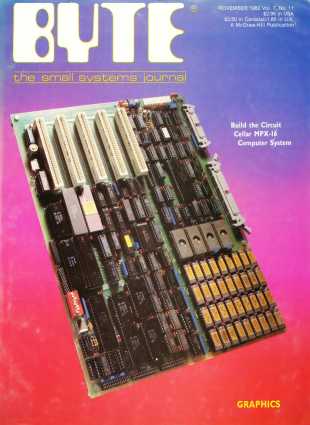
An overview of the state of the art in computer graphics as gleaned from a day at the fair.
[author : Alexander Pournelle]
A behind-the-scenes look at the development of the computer-generated graphics in Disney Studio's film Tron.
[author : Peter Sørensen]
Any peripheral device designed to be installed in the IBM Personal Computer can be plugged into this 8088-based system.
[author : Steve Ciarcia]
Find out how a complex design can be broken down into surprisingly simple components.
[author : William Weinreb]
Capture any video image for processing by your computer.
[author : Michael Keryan]
The color registers on the Atari 400 and 800 give programmers amazing animation capabilities, even in BASIC
[author : David Fox and Mitchell Waite]
A detailed look at a third-generation microcomputer that really gets down to business.
[author : Phil Lemmons]
The chief designer of the Victor 9000 discusses microcomputer design, marketing, and the industry's future.
[author : Phil Lemmons]
You'll thrill to the highs and lows of this simulated flight game. It's the fourth-place winner in the BYTE Game Contest.
[author : Eugene Szymanski]
You really put your game-playing skills to the test in this chase in which dragons pursue a rat that's after some cheese. As your skills improve the pace quickens. It captured third place in the BYTE Game Contest.
[author : Truck Smith]
Details of an easy-to-use, consumer-quality computer console.
[author : Chris Rutkowski]
The widespread use of keyboards as input and control devices for microcomputers has generated renewed interest in an old problem.
[author : Phil Lemmons]
The columnist answers a few letters and passes on some interesting observations from readers.
[author : Jerry Pournelle]
A practical look at the devices that put real-world interfaces to work.
[author : William Barden Jr.]
Microcomputers can create quite a variety of graphics.
[author : Gregg Williams]
Understanding the theory of perspective helps you to represent three-dimensional objects on a two-dimensional screen.
[author : Andrew Pickholtz]
Vector displays produce images far sharper than "high-resolution" raster types.
[author : Billy Garrett]
[author : Peter Callamaras]
[author : James R. DeKock]
[author : Peter Callamaras]
[author : Arthur Little]
This month we're proud to present the Circuit Cellar MPX-16 computer system, designed and developed by Steve Ciarcia. In this exclusive three-part article, Steve will discuss all the design aspects of his IBM-compatible computer based on the Intel 8088 microprocessor. Our cover photograph (© 1982 by Jonathan Goell) shows the MPX-16 as a single-board computer composed of the processor, the memory, parallel and serial interfaces, a disk controller, and expansion slots. We hope you'll enjoy Steve's most extensive technical project to date. Our theme this month is graphics, and we have some interesting features. "Tronic Imagery" is a behind-the-scenes look at the development of the computer-generated graphics in Disney Studio's epic film Tron. Gregg Williams provides an introduction to computer graphics in "A Graphics Primer," and Alexander Pournelle takes us on a tour of " The Third NCGA and the Future of Computer Graphics." In "Build a Video Digitizer" Michael Keryan shows you how to construct a video "frame grabber," and in "Microvec: The Other Type of Video Display" Billy Garrett describes how to construct an inexpensive vector graphics display. Andrew Pickholtz discusses "Interactive 3-D Graphics for the Apple II." And we have reviews of the Victor 9000, Cambridge Development Labs graphics board, The Graphics Magician, and the Executive Briefing System. Plus more Game Contest winners, the User's Column, and our regular features.
